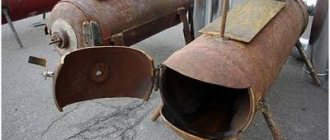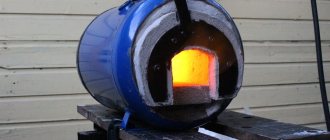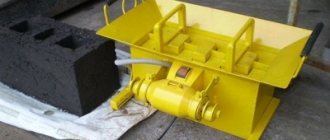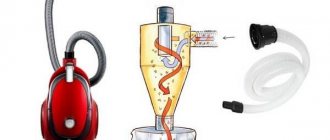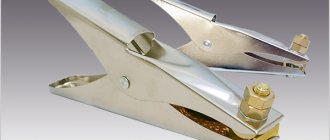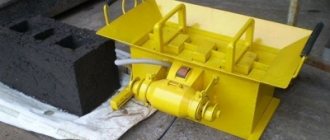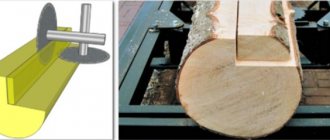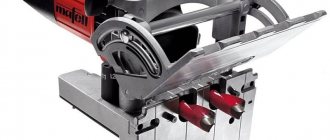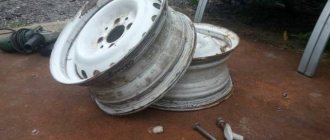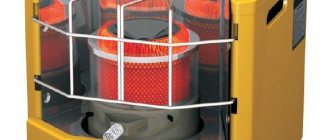An induction furnace can be used to melt small amounts of metal, separate and purify precious metals, and heat metal products to harden or temper them.
In addition, such stoves are proposed to be used for heating the home. Induction furnaces are commercially available, but it is more interesting and cheaper to make such a furnace yourself.
Crucible furnaces with transistor converter
Used for limited weight non-ferrous metals.
They are mobile, light in weight and can be easily moved from place to place. The furnace package includes a high-voltage transistor converter of universal action. Allows you to select the power recommended for connecting to the network, and, accordingly, the type of converter that is needed in this case with changing the weight parameters of the alloy. Transistor induction furnace is widely used in metallurgical processing. With its help, parts are heated in blacksmithing and metal objects are hardened. Crucibles in transistor furnaces are made of ceramics or graphite; the former are designed to melt ferromagnetic metals such as cast iron or steel. Graphite is installed to melt brass, copper, silver, bronze and gold. They melt glass and silicon. Aluminum melts well using cast iron or steel crucibles.
Types of equipment
Only two types of furnaces are widely used: crucible and channel. They have similar advantages and disadvantages, the differences lie only in the method of operation used:
- In a crucible type furnace it is necessary to load each portion of the charge separately. The principle of operation of the device is as follows: the metal is loaded inside the inductor, after melting it is drained and a new portion is loaded. As a rule, such a model is purchased for small workshops when work is carried out with a small amount of raw materials.
- Channel ones differ in that they allow metal melting to be carried out continuously. The design allows loading of a new portion of metal and draining of already molten metal during operation. The only disadvantage is that difficulties arise at the time of draining, since the drain channel must be filled.
The most popular type of induction furnace is the crucible type. This is due to their high performance and ease of operation. In addition, if necessary, such a design can be made independently.
Homemade versions are quite common. To create them you need:
- Generator.
- Crucible.
- Inductor.
An experienced electrician, if necessary, can make an inductor with his own hands. This structural element is represented by a winding of copper wire. The crucible can be purchased at the store, but a lamp circuit, a self-assembled battery of transistors, or a welding inverter are used as a generator.
Using a welding inverter
An induction furnace for melting metal with your own hands can be created by using a welding inverter as a generator. This option has become the most widespread, since the efforts made relate only to the manufacture of the inductor:
- Thin-walled copper tube is used as the main material. The recommended diameter is 8-10 cm.
- The tube is bent according to the desired pattern, which depends on the characteristics of the housing used.
- There should be a distance of no more than 8 mm between the turns.
- The inductor is placed in a textolite or graphite housing.
After creating the inductor and placing it in the housing, all that remains is to install the purchased crucible in its place.
Application of transistors
Such a circuit is quite complex to implement and involves the use of resistors, several diodes, transistors of various capacities, a film capacitor, copper wire with two different diameters and inductor rings. Assembly recommendations are as follows:
- When using the scheme in question, the structure will become very hot. This is why efficient cooling should be used.
- The purchased capacitors are assembled into one circuit to form a battery.
- Throttle rings are used as the basis for the inductor. A previously purchased copper tube with a diameter of about 1 mm is wound onto them. The number of turns determines how powerful the homemade stove will be. The recommended range is from 7 to 15 turns.
- A second copper tube is wound around a cylindrical object, the diameter of which should be about 2 mm. It is worth considering that the ends of this tube should be left large, since they will be used to connect to the power source.
- A 12 V battery can be used as a power source.
The created circuit is placed in a textolite or graphite case, which are dielectrics. The circuit involving the use of transistors is quite complex to implement. Therefore, you should undertake the manufacture of such a stove only if you have certain work skills.
Lamp stove
Lately, lamp-based stoves have been created less and less frequently, as they require careful handling. The circuit used is simpler compared to the case of using transistors
Assembly can be carried out in several stages:
- 4 beam lamps are used as a current generator, which are connected in parallel.
- The copper wire used must be connected in a spiral. The coils created must have a diameter of 8 to 16 cm, with a distance of at least 5 millimeters between them. It is worth considering that you will need a fairly large amount of wire, since the crucible must fit inside the turns.
- The created spiral is placed in a housing made of a material that does not conduct electric current.
- The efficiency of the circuit can be increased by additionally connecting a trimmer capacitor.
The llamas used must be protected from mechanical impact.
Benefits of heating
- does not require a separate room, is silent;
- duplication with other heating methods is possible;
- no preventive maintenance is required;
- the scale level is minimal due to constant vibration of the system;
- any liquid coolants are applicable (water, antifreeze, oil and others);
- constant circulation of the coolant in the system eliminates the possibility of overheating;
- durable, mechanical wear of elements is minimal;
- the system is environmentally friendly - there are no emissions of any hazardous fuel decomposition products;
- meets fire safety requirements.
Advantages of self-assembly of a heating device
However, induction boilers, although they run on electricity, are quite economical.
But this is not the whole list of their advantages.
By deciding to install such a device, you can get:
- Fast heating of the coolant. This takes on average 3-5 minutes.
- Efficiency is close to 100%, since almost all electrical energy is converted into heat.
- High temperature of liquid heating in the heating circuit, minimum – 35 °C.
- Lack of scale on the internal surfaces of the device, which is explained by the vibrations that occur during operation of the device. They prevent the formation of deposits.
- Long service life, since there are no moving or rubbing mechanisms and parts. Accordingly, there is no wear and tear on the equipment and no damage to its components.
- There is no need to remove combustion products and carry out frequent maintenance activities.
There are not many disadvantages of induction boilers. First of all, this is the fairly high cost of the equipment. In addition, the devices produce a slight vibration noise during operation.
Another disadvantage is the rather large mass, which must be taken into account when mounting the device on the wall.
To get the maximum effect from using an induction boiler, both homemade and serial, you need to connect them in a group and use them alternately or all at once
Advantages of Melting
Induction heating is direct, non-contact and its principle allows the generated heat to be used with maximum efficiency. The efficiency factor (efficiency) when using this method tends to 90%. During the melting process, thermal and electrodynamic movement of the liquid metal occurs, which contributes to uniform temperature throughout the entire volume of the homogeneous material.
The technological potential of such devices creates advantages:
- performance – can be used immediately after switching on;
- high speed of the melting process;
- possibility of adjusting the melt temperature;
- zonal and focused energy orientation;
- uniformity of molten metal;
- no waste from alloying elements;
- environmental cleanliness and safety.
Principle of operation
Such a furnace device is an electrical transformer with a secondary short-circuited winding. The operating principle of an induction furnace is as follows:
- using a generator, an alternating current is created in the inductor;
- an inductor with a capacitor creates an oscillatory circuit, it is tuned to the operating frequency;
- in the case of using a self-oscillating generator, the capacitor is excluded from the device circuit and in this case the inductor’s own reserve capacitance is used;
- the magnetic field created by the inductor can exist in free space or be closed using an individual ferromagnetic core;
- the magnetic field acts on the metal workpiece or charge located in the inductor and forms a magnetic flux;
- according to Maxwell's equations, it induces a secondary current in the workpiece;
- with a solid and massive magnetic flux, the created current is closed in the workpiece and a Foucault current or eddy current is created;
- after the formation of such a current, the Joule-Lenz law comes into effect, and the energy obtained using an inductor and a magnetic field heats the metal workpiece or charge.
Despite multi-stage operation, the induction furnace device can provide up to 100% efficiency in vacuum or air. If the medium has magnetic permeability, then this indicator will increase; in the case of a medium made of a non-ideal dielectric, it will fall.
Tilt mechanism
The tilting mechanism must ensure that the furnace is tilted to completely drain the metal.
Currently, a wide variety of mechanisms are used. For small-capacity furnaces, mechanisms are used consisting of a winch with a manual or electromechanical drive and a cable thrown over a block.
Larger stoves are tilted using a hoist, engaging its hook with an earring mounted on the frame. Large furnaces are equipped with a hydraulic tilt drive, which is in principle similar to the hydraulic tilt drive of arc furnaces.
The rotation of the furnace is carried out, as a rule, around axles, the axis of which passes under the toe of the furnace. In some cases, rotation begins around the lower trunnions and is carried out at high speed until the upper trunnions fit into the socket. After this, the furnace rotates around the upper pair of axles, but at a lower speed (the radius of the point of application of forces increases).
Build process
A do-it-yourself induction crucible furnace consists of an inductor, which is a solenoid made from a water-cooled copper tube and a crucible, which can be made of ceramic materials, and sometimes of steel, graphite and others. In such a device you can smelt cast iron, steel, precious metals, aluminum, copper, magnesium. Do-it-yourself induction furnaces are made with a crucible capacity from a couple of kilograms to several tons. They can be vacuum, gas-filled, open and compressor. The furnaces are powered by high, medium and low frequency currents.
So, if you are interested in making your own induction furnace, the scheme involves the use of the following main components: a melting bath and an induction unit, which includes a hearth stone, an inductor and a magnetic core. A channel furnace differs from a crucible furnace in that electromagnetic energy is converted into thermal energy in the heat release channel, in which there must always be an electrically conductive body. To make the initial start-up of a channel furnace, molten metal is poured into it or a template made of a material that can be straightened in the furnace is inserted. When the melting is completed, the metal is not completely drained, but a “swamp” remains, intended to fill the heat release channel for future start-up. If you are going to build an induction furnace with your own hands, then to make it easier to replace the hearth stone for the equipment, it is made detachable.
Crucible furnaces with transistor converter
Used for limited weight non-ferrous metals. They are mobile, light in weight and can be easily moved from place to place. The furnace package includes a high-voltage transistor converter of universal action
. Allows you to select the power recommended for connecting to the network, and, accordingly, the type of converter that is needed in this case with changing the weight parameters of the alloy.
Transistor Induction Furnace
Widely used for metallurgical processing. With its help, parts are heated in blacksmithing and metal objects are hardened. Crucibles in transistor furnaces are made of ceramics or graphite; the former are designed to melt ferromagnetic metals such as cast iron or steel. Graphite is installed to melt brass, copper, silver, bronze and gold. They melt glass and silicon. Aluminum melts well using cast iron or steel crucibles.
Channel melting device
The channel type induction steelmaking furnace has an electromagnetic core in its design. The operating principle of the device is the movement of an alternating magnetic flux through a magnetic circuit. An electric current is excited in a ring containing liquid metal, heating the charge to a predetermined temperature. The technology is used in foundries, mixers, and food serving tables. To increase the magnetic flux, a closed-type magnetic conductor made of transformer steel is used.
Channel furnaces got their name from the presence in the space of the unit of two holes with a channel forming a closed loop. Due to its design features, the device cannot operate without a circuit, thanks to which liquid aluminum is in continuous motion. If the manufacturer's recommendations are not followed, the equipment switches off spontaneously, interrupting the melting process.
Liquid bronze is poured through a siphon located on the end wall, additives and slags are loaded and removed through special holes. The finished product is dispensed through a V-shaped drain channel made in the lining according to a template, which is melted during the working process. Cooling of the winding and core is carried out by air mass, the temperature of the housing is regulated using water.
How the cooling circuit is organized
Large installations are equipped with forced systems to normalize the temperature regime; such design options are quite often found in production. For refilling, water or antifreeze is used, depending on the intensity of the work process.
There are units that provide air cooling, but in such a situation the fan is removed at a sufficient distance; only by organizing such a condition will it be possible to realize the plan. If this is not done correctly, the windings and components of the accessory will cause eddy current circuits and the efficiency of the equipment will decrease.
Induction heat generator in a heating system
To organize heating of a private house using an induction heater, the easiest way is to use a transformer, which consists of a primary and secondary short-circuited winding. Eddy currents in such a device arise in the internal component and direct the resulting electromagnetic field to the secondary circuit, which simultaneously serves as a housing and a heating element for the coolant.
Please note that not only water, but also antifreeze, oil and any other conductive media can act as a coolant during induction heating. In this case, the degree of purification of the coolant does not matter much. The inverter heater is compact in size, operates silently and can be installed in almost any suitable location that meets safety requirements
The inverter heater is compact in size, operates silently and can be installed in almost any suitable location that meets safety requirements
Most often, in the manufacture of homemade vortex induction heaters, inexpensive models of welding inverters are used, since they are convenient and fully comply with the requirements
It should be noted that you should not test the device if no coolant is supplied to it, otherwise the plastic case may melt very quickly.
An interesting version of an induction heater made from a hob is presented in the video:
To increase the safety of the structure, it is recommended to insulate the exposed areas of the copper coil.
The induction heating system should be placed at least 30 cm from walls and furniture and at least 80 cm from the ceiling or floor.
To make the operation of the device safer, it is recommended to equip it with a pressure gauge, as well as an automatic control system and devices for removing air trapped in the system.
A simple induction heater consists of a powerful high-frequency generator and a low-resistance coil-circuit, which is the load of the generator. The self-excited generator generates pulses based on the resonant frequency of the circuit. As a result, a powerful alternating electromagnetic field with a frequency of about 35 kHz appears in the coil. If a core of conductive material is placed in the center of this coil, electromagnetic induction will occur inside it. As a result of frequent changes, this induction will cause eddy currents in the core, which in turn will lead to the release of heat. This is the classic principle of converting electromagnetic energy into thermal energy. Induction heaters have been used for a very long time in many areas of production. With their help, you can do hardening, non-contact welding, and most importantly, spot heating, as well as melting of materials. I'll show you the circuit of a simple low-voltage induction heater, which has already become a classic.
Items you will need:
Inductor in the kitchen
Induction hob
Induction hobs have become commonplace in the kitchen, see fig. According to the principle of operation, this is the same induction stove, only the bottom of any metal cooking vessel acts as a short-circuited secondary winding, see fig. on the right, and not just from ferromagnetic material, as the ignorant often write. Aluminum cookware is simply falling out of use; doctors have proven that free aluminum is a carcinogen, and copper and tin have long been out of use due to toxicity.
Household induction cookers are a product of the age of high technology, although the idea arose simultaneously with induction melting furnaces. Firstly, to isolate the inductor from the cooking, a durable, resistant, hygienic and EMF-free dielectric was needed. Suitable glass-ceramic composites have come into production relatively recently, and the top plate of the slab accounts for a significant portion of its cost.
Kitchen induction hob diagram
Then, all cooking vessels are different, and their contents change their electrical parameters, and the cooking modes are also different. A specialist will not be able to do this by carefully tightening the knobs to the desired fashion; you need a high-performance microcontroller. Finally, according to sanitary requirements, the current in the inductor must be a pure sinusoid, and its magnitude and frequency must vary in a complex way according to the degree of readiness of the dish. That is, the generator must have digital generation of the output current, controlled by the same microcontroller.
There is no point in making a kitchen induction hob yourself: more money will be spent on electronic components alone at retail prices than on ready-made good tiles. And it’s still quite difficult to control these devices: anyone who has one knows how many buttons or sensors there are with the inscriptions: “Stew”, “Roast”, etc. The author of this article saw a tile that separately listed “Navy Borscht” and “Pretanier Soup.”
However, induction cookers have many advantages over others:
- Almost zero, unlike microwave ovens, PPE, even if you sit on this tile yourself.
- Possibility of programming for preparing the most complex dishes.
- Melting chocolate, rendering fish and poultry fat, preparing caramel without the slightest sign of burning.
- High efficiency as a result of fast heating and almost complete concentration of heat in the cooking vessel.
Heating up cooking utensils on an induction hob and gas burner
To the last point: take a look at fig. on the right, there are schedules for heating up cooking on an induction stove and a gas burner. Anyone who is familiar with integration will immediately understand that an inductor is 15-20% more economical, and there is no need to compare it with a cast-iron “pancake”. The cost of money on energy when preparing most dishes for an induction cooker is comparable to that of a gas cooker, and even less for stewing and cooking thick soups. The inductor is so far inferior to gas only during baking, when uniform heating is required on all sides.
Video: failed induction heater from a kitchen stove
Instructions for making an induction heater
To convert welding equipment into an induction furnace, you need to prepare consumables and tools
It is also important to prepare drawings and follow the assembly instructions
A simple product based on a welding inverter
To make a simple but effective heater, you can use a welding inverter. The manufacturing process is quite simple:
- First you need to take a thick-walled polymer tube.
- It is worth installing wiring and 2 valves at the end of the pipe, and pouring pieces of steel wire of small diameter and size (5 mm) inside.
- Secure the top valve.
- Make 90 turns of copper wire to assemble the inductor.
A welding machine is used as a generator, and a tube with wire plays the role of a heater. The device is set to AC mode with increased frequency.
During the heating process, a magnetic field is emitted and the wire is heated by vortex flows. This causes the liquid to boil.
Experimental model of a 1600 W heater
To assemble experimental equipment with a power of 1.6 kW, you will need to prepare a metal pipe with thick walls. Since the coil can heat any material without much difficulty, the heater can be improved.
The housing can be made from a plastic pipe, which has a larger diameter than the heating system element. The optimal length of the product is 1 m, and the internal cross-section is 50-80 mm.
To connect the heater to the equipment, you will need to attach adapters to the top and bottom of the housing. The lower section is covered with a grill, and then a filler of small metal particles is placed inside the housing.
Copper wire with insulation with a cross section of 1-1.5 mm is suitable for the winding. The use of thicker wire is unjustified, since this will complicate the tight arrangement of the turns.
Furnace for heating metal
Due to increased fire safety, the induction method is used in metallurgy. You can assemble a heater for processing metal workpieces using available materials. For the upcoming work you will need to prepare:
- 12 volt battery.
- Copper winding wire.
- Film capacitors.
- Transistors and diodes.
- Power supply rings from a personal computer.
Induction furnace made from a welding inverter.
Subsequent assembly is carried out according to the following instructions:
Transistors are installed on cooling radiators. During use, the device heats up intensely, so it is better to prepare large radiators. Chokes are being manufactured. To assemble them, copper wire and PC power supply rings are used.
It is important to ensure that the interturn distance remains identical in each segment. The capacitor bank is assembled. The battery capacity should be 4.7 µF. The winding is being made
The diameter of the copper wire should be 2 mm. It will be necessary to perform 8 turns so that all the parts to be processed fit into the internal space.
The last step is to connect the battery. The current is adjusted during the manufacture of the furnace. To do this, just change the number of turns.
In addition, a heat removal and ventilation system should be provided, because The oven becomes very hot during operation.
Water heater
Using such a unit in a private home will allow you to organize an uninterrupted supply of hot water or heating the room. The system consumes a lot of electrical energy, but has a simple assembly circuit and is not difficult to maintain. The upcoming assembly begins with preparation:
- Welding inverter.
- Thermal insulator (expanded clay is suitable).
- Wires made of copper and steel.
- A piece of plastic pipe with thick walls.
- Tubes of different diameters.
At the first stage, the manufacture of the boiler begins. It can be constructed from 2 tubes of different sections, which are inserted into each other with a gap of 20-25 mm.
Next, the ends of the rings are welded and connected to the general heating system. The outlet and inlet tubes need to be welded into the outer wall.
Then a winding is made that exactly follows the shape of the boiler. In total, you need to perform 35-40 turns, maintaining an equal interturn distance.
At the last stage, a protective housing is assembled, which is made of dielectric material, and the inverter apparatus and coolant are connected.
A properly assembled structure can last for 20-25 years without repairs or replacement of consumables.
Homemade water heating boiler
The basis of such a water heater is a power transformer with a power of up to 1.5 kW, the primary winding of which is designed for a voltage of 220 V. A transformer from a tube color TV is ideal. The secondary winding should be removed, and the number of turns of the primary should be increased.
Craftsmen advise and warn: using such a homemade device is unsafe, so the transformer should be grounded, and the device itself should be connected through a high-speed RCD.
Designs and parameters of induction furnaces
Channel
One of the options for making an induction furnace with your own hands is a channel one.
For its manufacture, you can use a conventional welding transformer operating at a frequency of 50 Hz.
In this case, the secondary winding of the transformer must be replaced with a ring crucible.
In such a furnace you can melt up to 300-400 g of non-ferrous metals, and it will consume 2-3 kW of power. Such a furnace will have high efficiency and will allow the smelting of high quality metal.
The main difficulty in making a channel induction furnace with your own hands is purchasing a suitable crucible.
To make the crucible, a material with high dielectric properties and high strength must be used. Such as electroporcelain. But such material is not easy to find, and even more difficult to process at home.
Crucible
The most important elements of an induction crucible furnace are:
- inductor;
- power supply generator.
As an inductor for crucible furnaces with a power of up to 3 kW, you can use a copper tube or wire with a diameter of 10 mm or a copper busbar with a cross-section of 10 mm². The diameter of the inductor can be about 100 mm. The number of turns is from 8 to 10.
In this case, there are many modifications of the inductor. For example, it can be made in the form of a figure eight, trefoil or other shape.
During operation, the inductor usually becomes very hot. In industrial designs, the inductor uses water cooling of the turns.
At home, using this method is difficult, but the inductor can work normally for 20-30 minutes, which is quite enough for home work.
However, this mode of operation of the inductor causes the appearance of scale on its surface, which sharply reduces the efficiency of the furnace. Therefore, from time to time the inductor has to be replaced with a new one. To protect against overheating, some experts suggest covering the inductor with a heat-resistant material.
The high-frequency alternating current generator is another important element of an induction-type crucible furnace. Several types of such generators can be considered:
- transistor generator;
- thyristor generator;
- generator using MOS transistors.
The simplest alternating current generator to power an inductor is a self-excited generator, the circuit of which has one KT825 type transistor, two resistors and a feedback coil. Such a generator can generate power up to 300 W, and the generator power is adjusted by changing the DC voltage of the power source. The power source must provide a current of up to 25 A.
The thyristor generator proposed for the crucible furnace includes in the circuit a T122-10-12 type thyristor, a KN102E dinistor, a number of diodes and a pulse transformer. The thyristor operates in pulse mode.
The analysis of the circuit showed that in such a circuit there are quite powerful parasitic oscillations at frequencies close to 120 MHz.
DIY induction furnace
Such microwave radiation can negatively affect human health. In accordance with Russian safety standards, it is allowed to work with high-frequency vibrations at an electromagnetic energy flux density of no more than 1-30 mW/m². For this generator, as calculations have shown, this radiation at a distance of 2.5 m from the source reaches 1.5 W/m². This value is unacceptable.
The MOSFET oscillator circuit includes four MOSFET transistors of the IRF520 and IRFP450 types and is a push-pull oscillator with independent excitation and an inductor included in a bridge circuit. An IR2153 type microcircuit is used as a master oscillator. To cool the transistors, a radiator of at least 400 cm² and airflow are required. This generator can provide power up to 1 kW and vary the oscillation frequency from 10 kHz to 10 MHz. Thanks to this, a furnace using a generator of this type can operate in both melting and surface heating modes.
Features of operation
An important issue when using an induction oven is safety.
As mentioned above, crucible-type furnaces use high-frequency power sources.
At the same time, self-made generators can emit parasitic high-frequency vibrations, which can cause certain harm to human health.
Therefore, when operating an induction furnace, the inductor must be positioned vertically; before turning on the furnace, a grounded shield must be put on the inductor. When the furnace is turned on, it is necessary to observe the processes occurring in the crucible from a distance, and after completing the work, immediately turn it off.
When operating a home-made induction furnace, you must:
- Take measures to protect the oven user from possible high frequency radiation.
- Take into account the possibility of burns from the inductor.
When working with a stove, thermal hazards must also be taken into account. Touching the skin with a hot inductor can cause severe burns.
Working principle of induction heater
Induction heating is impossible without the use of three main elements:
- inductor;
- generator;
- heating element.
An inductor is a coil, usually made of copper wire, that generates a magnetic field. An alternator is used to produce a high-frequency current from the standard 50 Hz household electrical current.
A metal object capable of absorbing thermal energy under the influence of a magnetic field is used as a heating element. If you combine these elements correctly, you can get a high-performance device that is perfect for heating liquid coolant and heating a home.
Image gallery Regardless of the design complexity, dimensions and tasks to be solved, its main components are an inductor, an eddy current generator and a heating element. The undoubted advantage of induction heaters is rapid heating with significantly lower electricity requirements compared to other heating devices. A significant disadvantage of induction heaters is recognized as the obligatory need for a source energy. Without electricity, the device is completely useless. If a homemade induction heater is installed on a metal heating pipeline, it will not only effectively heat the coolant, but also stimulate the movement of the heated liquid along the circuit. In order for the inverter to work normally in a circuit with an induction coil, it is connected through a thermostat. Rectifier diodes are connected to the outputs, otherwise the system will work as an electromagnet, and not as an induction heater. The simplest generator of induction currents for a home-made heater will be an inverter, usually used in electric welding. An induction coil that generates eddy currents is connected to the poles of the inverter, which, when connected to the network, immediately starts generate thermal energy The principle of induction is used not only in the preparation of coolant and heating of sanitary water for hygienic purposes. It is used in metal smeltingAssembling a simple induction heaterFast heating with eddy currentsRequired access to an energy sourceHeating a metal tubeUpgrading a conventional inverterUsing an inverter as a generatorInduction coil connection pointsUsing induction in metal smelting
Using a generator, an electric current with the necessary characteristics is supplied to the inductor, i.e. onto a copper coil. When passing through it, a stream of charged particles forms a magnetic field.
The operating principle of induction heaters is based on the occurrence of electric currents inside conductors that appear under the influence of magnetic fields
The peculiarity of the field is that it has the ability to change the direction of electromagnetic waves at high frequencies. If any metal object is placed in this field, it will begin to heat up without direct contact with the inductor under the influence of the created eddy currents.
The high-frequency electric current supplied from the inverter to the induction coil creates a magnetic field with a constantly changing vector of magnetic waves. Metal placed in this field heats up quickly
The absence of contact makes it possible to make energy losses during the transition from one type to another negligible, which explains the increased efficiency of induction boilers.
To heat water for the heating circuit, it is enough to ensure its contact with a metal heater. Often a metal pipe is used as a heating element, through which a stream of water is simply passed. The water simultaneously cools the heater, which significantly increases its service life.
The electromagnet of an induction device is obtained by winding wire around a ferromagnet core. The resulting induction coil heats up and transfers heat to the heated body or the coolant flowing nearby through the heat exchanger
Operating principle
The operating principle of an induction furnace is based on heating the material using eddy currents.
To obtain such currents, a so-called inductor is used, which is an inductor coil containing only a few turns of thick wire.
The inductor is powered by a 50 Hz alternating current network (sometimes through a step-down transformer) or from a high-frequency generator.
The alternating current flowing through the inductor generates an alternating magnetic field that permeates space. If there is any material in this space, then currents will be induced in it, which will begin to heat this material. If this material is water, then its temperature will increase, and if it is metal, then after a while it will begin to melt.
There are two types of induction furnaces:
- furnaces with magnetic core;
- ovens without a magnetic core.
The fundamental difference between these two types of furnaces is that in the first case the inductor is located inside the melting metal, and in the second - outside. The presence of a magnetic circuit increases the density of the magnetic field penetrating the metal placed in the crucible, which facilitates its heating.
Induction heater
An example of an induction furnace with a magnetic core is a channel induction furnace. The circuit of such a furnace includes a closed magnetic circuit made of transformer steel, on which the primary winding is located - an inductor and a ring-shaped crucible in which the material for melting is located. The crucible is made of heat-resistant dielectric. Such an installation is powered from an alternating current network with a frequency of 50 Hz or a generator with an increased frequency of 400 Hz.
Such furnaces are used for melting duralumin, non-ferrous metals or producing high-quality cast iron.
Crucible furnaces that do not have a magnetic core are more common. The absence of a magnetic circuit in the furnace leads to the fact that the magnetic field created by industrial frequency currents is strongly dissipated in the surrounding space. And in order to increase the magnetic field density in a dielectric crucible with material to be melted, it is necessary to use higher frequencies. It is believed that if the inductor circuit is tuned to resonance with the frequency of the supply voltage, and the diameter of the crucible is commensurate with the resonance wavelength, then up to 75% of the energy of the electromagnetic field can be concentrated in the crucible area.
Induction furnace manufacturing diagram
As studies have shown, to ensure efficient melting of metals in a crucible furnace, it is desirable that the frequency of the voltage supplying the inductor exceeds the resonant frequency by 2-3 times. That is, such a furnace operates at the second or third frequency harmonic. In addition, when operating at such higher frequencies, the alloy is better mixed, which improves its quality. A mode using even higher frequencies (fifth or sixth harmonics) can be used for surface carburization or hardening of metal, which is associated with the appearance of a skin effect, that is, the displacement of a high-frequency electromagnetic field to the surface of the workpiece.
Conclusions on the section:
- There are two options for an induction furnace - with a magnetic core and without a magnetic core.
- The channel furnace, which belongs to the first version of the furnaces, is more complex in design, but can be powered directly from a 50 Hz network or a high-frequency network of 400 Hz.
- The crucible furnace, which belongs to the furnaces of the second type, is simpler in design, but requires a high-frequency generator to power the inductor.
If a stove is a heating device for practical needs, then a fireplace is needed for decoration and comfort. DIY fireplace: step-by-step assembly instructions, as well as an example of how to arrange a fireplace with an arch.
Read about how to choose the right electric heating boiler here.
And here https://microklimat.pro/otopitelnoe-oborudovanie/kotly/avtomatika-dlya-gazovyx.html you will learn how automation for gas heating boilers works. Boilers by installation method and types of energy-dependent systems.

